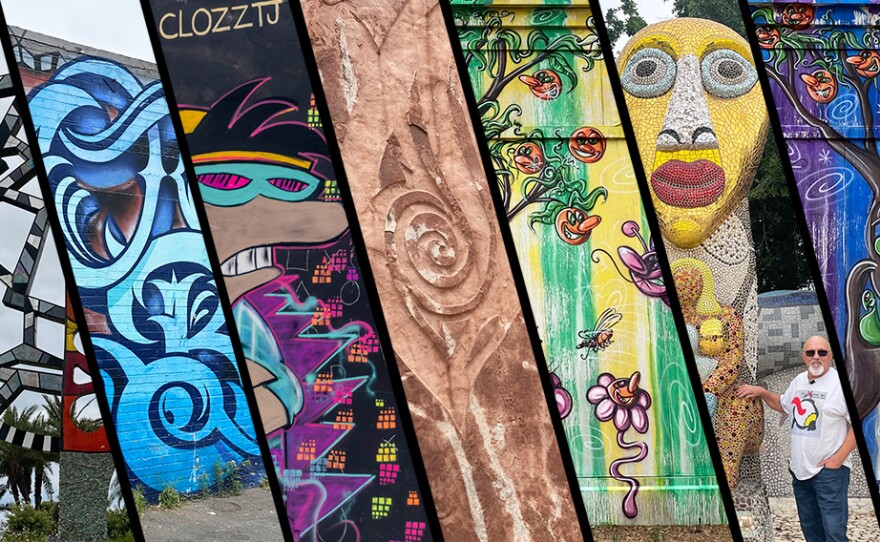At the corner of Imperial Avenue and 20th Street in Barrio Logan sits a mural of quintessential San Diego images.
A friar representing the Padres. A church. The trolley. Houses. A railroad crossing. And in calligraphy are the words “America’s Finest City.” Its multiple shades of blue pop from the sidewalk.
Graffiti artist Dyse One co-painted the mural with his friend Hasl six years ago. It adorns the front wall of his streetwear store called Dyse One Clothing.
“I paint a lot of San Diego stuff just so people can enjoy,” Dyse One said. “It’s my city. I love my city. I see it as a gift. And from what I've seen in the last six years, as long as it's been running, people love it.”
He believes scores of people have caught glimpses of the mural traveling east on Imperial Avenue — one of San Diego’s longest and busiest streets — and from Interstate 5 and by simply walking the neighborhood.
“I don’t think you can get more public art than this,” Dyse One said.
In an age of polarization and alienation, public art remains one of the few spaces that still binds, awes, inspires and educates. It’s where artists, sometimes with public or private funding, have partnered to give beauty and provoke thought.

Point Loma Nazarene University art history professor Jim Daichendt said the most successful public art is like Dyse One’s mural — it speaks to the community about itself. On a recent morning, Daichendt animatedly explained how the painting’s lines, shapes and forms unfold San Diego’s story.
“A mural like this absolutely stops people in their tracks,” Daichendt said. “You can think of the city of San Diego as the inspiration and the writing on the wall as a poem, a reflection, a creative interpretation of the things that are influencing the artist.”
The desire to share that creativity with the public forms the soul of many murals, graffiti, sculptures, statues, installations and other pieces that mark indoor and outdoor spaces across San Diego County. Daichendt described public art’s purpose as layered.
It can add beauty, he said.
“But it could also challenge us on a number of political, social, or any conceptual issues altogether,” Daichendt said. “Good work allows you to return to that work of art over and over again and continue to see new things. Almost like a conversation with an old friend that's full of surprises. As you ask new questions, new things are revealed.”
Public art can brand a place.
“What would the world be without the Statue of Liberty?” asked Christine Jones, chief of Civic Art Strategies at the city of San Diego. “What would San Diego be without Chicano Park?”
She ascribes powers to public art that go beyond aesthetics.
“It has components you can't see, which is more about its innate ability to really support social cohesion, a sense of belonging, a sense of neighborhood pride,” Jones said.
There are many forms of public art. Some artists install on their own in public places. And then there’s art commissioned by local governments.
The public art budget in San Diego is $5.7 million and includes an $85,000 public art allocation this fiscal year. The city’s collection totals nearly 800 artworks.
“It includes portable works, small sculptures, paintings, but also works that are commissioned as well, that are integrated into parks or libraries or other municipal buildings,” Jones said.

Right now, San Diego’s artwork is spread unevenly throughout the city. Downtown has almost half of all the civic artwork. Balboa Park comes in second. Meanwhile, neighborhoods such as Sherman Heights, Lincoln Park and Encanto each only have one.
Grants for public art also aren’t evenly distributed throughout the county. Unsurprisingly, the city of San Diego received the most funding from the California Arts Council, totaling $5.5 million between 2018 and 2020. That’s almost five times all the other cities in the county combined. Chula Vista, the second largest city in San Diego County, only received $18,500.
San Diego’s downtown Central Library also has almost 300 pieces of public art. It houses some of Jones’ favorite public art, including the library’s elevator, which contains dioramas with brightly colored elements from nature contrasted with visuals from the literary world and modern society.
“Somebody going into this elevator is launched into this discovery of the encyclopedic nature of what a library is,” Jones said. “(They’ve) created all these wonderful vignettes and niches with different types of found objects and materials.”
Step outside the library and public art abounds in the region. There’s the whimsical — think Niki de Saint Phalle’s exaggerated sculpture of an alligator outside the Mingei Museum. The participatory — a mosaic of community faces named “Place to Call Home” at Southcrest Trails Park. The startling, such as the tiny house titled “Fallen Star” perched atop the engineering building at UCSD. The colorful and captivating, like the murals at the California Center for the Arts in Escondido. And the iconic Chicano Park with its murals portraying Chicano history, culture, key civil rights activists and immigration.

Daichendt calls the area's public art robust. Finding it, he said, is similar to a scavenger hunt.
“I would challenge anyone that doesn't think it is to actually visit neighborhoods and to look and walk and engage with artists,” Daichendt said. “And you'll be amazed at how much there is.”
Back at the America’s Finest City mural, street performer James Havic heeds the credo. He said he passes the mural each day on his way to a nearby Walmart and is affected by what he sees.
“It calls to me,” Havic said. “It makes me feel part of. And I kind of like the homies. It’s a good representation of our community.”







